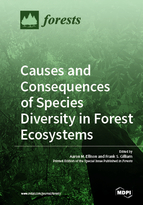Causes and Consequences of Species Diversity in Forest Ecosystems
A special issue of Forests (ISSN 1999-4907). This special issue belongs to the section "Forest Ecology and Management".
Deadline for manuscript submissions: closed (31 January 2019) | Viewed by 58364
Special Issue Editors
Interests: forest dynamics; old-growth forests; plant-animal interactions; statistics; succession
Interests: plant ecology; forest ecology; terrestrial ecosystems; forest herbaceous layer communities; longleaf pine, nitrogen biogeochemistry
Special Issues, Collections and Topics in MDPI journals
Special Issue Information
Dear Colleagues,
What are the causes and consequences of species diversity in forested ecosystems, and how is this species diversity being affected by rapid environmental and climatic change, movement of invertebrate and vertebrate herbivores into new biogeographic regions, and expanding human populations and associated shifts in land-use patterns? In this Special Issue of Forests, we explore these questions for assemblages of forest trees, shrubs, and understory herbs at spatial scales ranging from small plots to large forest dynamics plots, at temporal scales ranging from seasons to centuries, in both temperate and tropical regions, and across rural-to-urban gradients in land use.
Prof. Dr. Aaron M. EllisonProf. Dr. Frank S. Gilliam
Guest Editors
Manuscript Submission Information
Manuscripts should be submitted online at www.mdpi.com by registering and logging in to this website. Once you are registered, click here to go to the submission form. Manuscripts can be submitted until the deadline. All submissions that pass pre-check are peer-reviewed. Accepted papers will be published continuously in the journal (as soon as accepted) and will be listed together on the special issue website. Research articles, review articles as well as short communications are invited. For planned papers, a title and short abstract (about 100 words) can be sent to the Editorial Office for announcement on this website.
Submitted manuscripts should not have been published previously, nor be under consideration for publication elsewhere (except conference proceedings papers). All manuscripts are thoroughly refereed through a single-blind peer-review process. A guide for authors and other relevant information for submission of manuscripts is available on the Instructions for Authors page. Forests is an international peer-reviewed open access monthly journal published by MDPI.
Please visit the Instructions for Authors page before submitting a manuscript. The Article Processing Charge (APC) for publication in this open access journal is 2600 CHF (Swiss Francs). Submitted papers should be well formatted and use good English. Authors may use MDPI's English editing service prior to publication or during author revisions.
Keywords
- biogeochemistry
- competition
- facilitation
- herbivory
- succession
- understory







